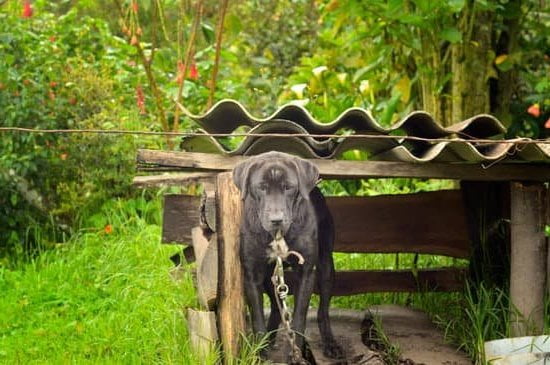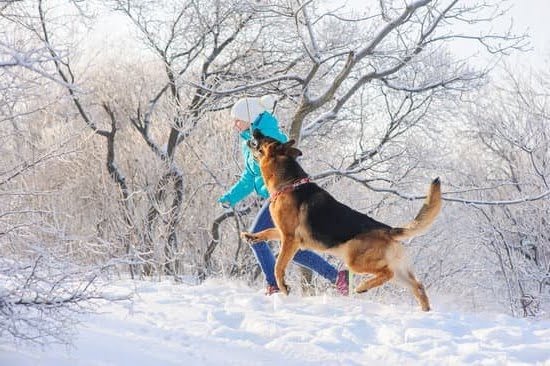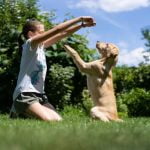Training your dog to follow the “place” command is an essential aspect of their overall obedience and behavior. In this article, we will delve into the importance of teaching dogs this command and the countless benefits that come with it. Having a well-trained dog that understands and follows the “place” command can greatly enhance their behavior, provide structure, and create a harmonious living environment for both you and your furry friend.
The “place” command refers to teaching your dog to go to a designated area or object and stay there until given further instruction. This command not only helps establish boundaries for your dog but also teaches them self-control, focus, and patience. When properly trained, dogs that follow the “place” command can enjoy more freedom in various situations while maintaining discipline and respect for their owners.
Having a well-trained dog that consistently follows the “place” command offers several advantages. First and foremost, it promotes safety by preventing dogs from wandering off or engaging in potentially dangerous behaviors.
Additionally, a dog that understands this command can be easily managed during social gatherings or outings, allowing them to remain calm and contained. This training also aids in establishing dominance hierarchy within your home, as it reinforces your role as the leader and your dog’s position in the pack.
In the following sections of this article, we will explore how to teach the “place” command effectively, including selecting an ideal location for training, establishing boundaries with your dog, employing positive reinforcement techniques, troubleshooting common challenges, and advancing their training beyond basic commands. By implementing these techniques consistently with patience and dedication, you can enjoy the many benefits of having a well-trained dog that eagerly follows the “place” command.
Understanding the “Place” Command
The “Place” command is a fundamental aspect of dog training that involves teaching dogs to go to a designated spot and remain there until released. This command plays a crucial role in establishing boundaries, ensuring safety, and promoting good behavior in dogs. By understanding the meaning and significance of the “place” command, dog owners can effectively train their pets and create a harmonious living environment.
For dogs, the “place” command refers to a specific area or object where they are expected to go and stay until given further instruction. This could be a dog bed, mat, or even a designated spot on the floor. The exact location can vary depending on personal preference and the needs of the household.
The primary significance of the “place” command lies in its ability to establish boundaries for dogs. It teaches them self-control, impulse management, and respect for personal space. By designating a specific spot for them to go to and stay, dogs learn to understand limits in their movements and actions. This is especially helpful in situations where keeping them contained or stationary is necessary for their safety or the convenience of others.
In addition to teaching boundaries, the “place” command also helps promote good behavior in dogs. When they have a clear designated spot where they are expected to be calm and well-behaved, it becomes easier for them to understand what is expected of them. This can help reduce unwanted behaviors such as jumping on furniture or begging at mealtimes. Ultimately, teaching dogs the “place” command creates a more disciplined and well-mannered pet that is enjoyable to be around.
To effectively train your dog on the “place” command, it is important to choose an ideal location or object that you want them to associate with this command. Consider factors such as accessibility, comfortability for your dog, and practicality within your home environment.
For example, if you have limited space or live in an apartment setting, choosing a small dog bed or mat that can easily fit in your living room might be the best option. Alternatively, if you want your dog to have their own special spot in every room, consider using portable mats or pillows that can be easily moved around as needed.
By understanding the significance and importance of the “place” command, dog owners can effectively train their pets and set boundaries for them. This command not only promotes good behavior but also enhances safety and creates a more harmonious living environment. In the following sections, we will discuss how to establish boundaries, step-by-step training process, positive reinforcement techniques, and troubleshooting common challenges in teaching dogs the “place” command.
Choosing the Ideal “Place”
When training a dog to follow the “place” command, it is crucial to select an ideal location or object that will serve as the designated spot for your dog. The choice of the “place” will greatly influence the success and effectiveness of the training process. This section will provide guidance on identifying suitable areas or objects to designate as the “place” and explore factors to consider when selecting the perfect spot for training.
Firstly, it is essential to choose a location or object that is comfortable and appealing for your dog. The “place” should be somewhere that your dog enjoys being and feels safe and secure. It could be a special mat, a specific bed, or even a designated area in your home. Avoid areas that are noisy, crowded, or too distracting for your dog, as these can hinder their focus and ability to learn.
In addition, consider the accessibility of the chosen “place”. Ideally, it should be easily accessible for your dog without any physical obstacles or stairs that might pose a challenge. This will ensure that your dog can quickly and confidently access their designated spot whenever given the command.
Furthermore, take into account any potential safety hazards in the chosen area. Remove any dangerous objects or substances that may harm your dog while they are on their “place”. Additionally, make sure there is enough space for your dog to comfortably lie down or sit without feeling cramped.
Ultimately, choosing an ideal “place” involves considering both your dog’s comfort and safety. By selecting an appealing location or object with easy accessibility and ensuring a hazard-free environment, you will set a solid foundation for successful training sessions with your furry friend.
| Factors to Consider | Guidance |
|---|---|
| Comfort | Select a location that your dog enjoys being and feels safe and secure. |
| Accessibility | Choose a spot that is easily accessible, without physical obstacles or stairs that may pose a challenge. |
| Safety | Ensure that the chosen area or object is free of any potential hazards or dangerous substances. |
Establishing Boundaries
Teaching your dog to understand and respect the boundaries of the “place” command is an essential aspect of training. By establishing clear boundaries, you can ensure that your dog follows the command consistently and stays in the designated area or object.
Defining the Boundaries
When teaching your dog the “place” command, it’s crucial to clearly define what constitutes the boundaries of their designated spot. This could be a mat, a dog bed, or any specific area you have chosen as their “place.” Start by introducing your dog to this spot and using verbal cues such as “go to your place” or “place.”
Gradually increase their understanding by using physical cues like pointing or leading them to the spot. Consistency is key during this process.
Reinforcing Boundaries
To reinforce the boundaries of the “place” command effectively, use positive reinforcement techniques. Whenever your dog willingly goes to their designated spot, reward them with treats, praise, or toys. This positive association helps them understand that staying within these boundaries brings rewards and reinforces their desired behavior.
Corrective Measures
While positive reinforcement is usually sufficient, some dogs may test the boundaries initially. In such cases, it’s important to establish corrective measures without resorting to punishment or harsh methods. When your dog tries to leave their designated spot without permission, gently guide them back to it using gentle leash pressure or verbal cues. Consistency and patience are crucial during this phase.
By consistently enforcing these boundaries in a positive and patient manner, your dog will learn to associate the “place” with their designated spot and stay within its limits.
Remember that each dog is unique, so it’s important to adapt these techniques based on your individual pet’s needs and personality traits. With time and effort, establishing strong boundaries for the “place” command will result in a well-trained dog that follows the command reliably.
Step-by-Step Training Process
The step-by-step training process is a crucial component in successfully teaching your dog the “place” command. By breaking down the training into manageable steps, you can ensure that your dog understands and follows the command effectively. Here are some tips to help you navigate the training process:
- Start with basic commands: Before introducing the “place” command, make sure your dog is familiar with basic obedience commands such as sit, stay, and come. This will establish a foundation of trust and communication between you and your dog.
- Introduce the concept of “place”: Begin by selecting a specific area or object that will serve as your dog’s designated “place.” This could be a mat, bed, or even a specific spot on the floor. Use treats or toys to encourage your dog to approach and explore the designated area.
- Associate verbal cue with “place”: Once your dog is comfortable approaching the designated area, introduce a verbal cue such as “place” or “go to your spot.” Say the cue consistently every time you direct your dog towards the designated area.
- Practice in short intervals: Start by asking your dog to go to their place for short durations, gradually increasing the time they are required to stay there. Use treats and rewards to reinforce their positive behavior when they remain in their place for longer periods.
- Add distractions: As your dog progresses in their understanding of the command, gradually introduce distractions during their “place” time. For example, have someone walk by them or toss a toy nearby. This will help teach them impulse control and reinforce their ability to stay focused on following the command despite distractions.
- Gradually increase distance: Once your dog has mastered staying in their place in close proximity to you, begin increasing the distance between you and them while they remain in place. This will train them to follow the command even when you are not within immediate reach.
Remember that consistency is key when training your dog the “place” command. Practice regularly, gradually increasing the difficulty level as your dog becomes more proficient. Be patient and always reward their successes to positively reinforce their behavior. With time and practice, they will become reliable in following the command in various settings.
Positive Reinforcement Techniques
When it comes to training your dog to follow the “place” command, positive reinforcement techniques can be highly effective. Positive reinforcement involves rewarding and praising your dog for exhibiting the desired behavior, in this case, following the “place” command. This type of training focuses on encouraging good behavior through rewards and positive experiences rather than punishment.
One common positive reinforcement technique is using treats as rewards. When your dog successfully follows the “place” command, give them a treat immediately to reinforce their behavior. It’s important to choose treats that they find highly motivating and enjoyable. Small, bite-sized treats are usually ideal for training purposes. Additionally, you can use verbal praise, such as saying “good place.” or “well done.” along with the treat to further reinforce their understanding of the command.
In addition to treats and verbal praise, other forms of rewards can be used in positive reinforcement training. For example, petting and affectionate gestures like belly rubs or gentle scratches behind the ears can also be highly rewarding for dogs. Some dogs may respond better to certain types of rewards over others, so it’s essential to observe your dog’s preferences and adjust your reinforcement techniques accordingly.
By consistently using positive reinforcement techniques, you will create a positive association with following the “place” command in your dog’s mind. They will begin to understand that good things happen when they obey this command, which enhances their motivation to continue doing so. Positive reinforcement not only strengthens your bond with your dog but also makes the training process more enjoyable for both of you.
Remember that positive reinforcement should always be used in conjunction with patience and consistency during training sessions. With time, practice, and plenty of encouragement, your dog will become proficient at following the “place” command through positive reinforcement techniques.
Overall, positive reinforcement is a valuable tool in teaching dogs the “place” command. By utilizing rewards and praise effectively, you can encourage your dog to consistently follow this command and enjoy the training process.
Troubleshooting Common Challenges
When training your dog to follow the “place” command, you may encounter some common challenges along the way. Understanding these difficulties and knowing how to address them will help ensure success in training. One common challenge is when your dog refuses to stay on the designated “place” for an extended period of time. This can be due to restlessness, distractions, or simply not understanding what is expected of them.
To overcome this challenge, it is important to make the “place” area as comfortable and appealing as possible for your dog. Ensure there is a soft bed or blanket on the designated spot and consider placing some of their favorite toys nearby. Gradually increase the duration that you expect your dog to stay on the place by starting with short intervals and gradually extending the time.
Another common challenge is when your dog tries to leave the designated area before being released from the “place” command. In this case, it is crucial not to give in or allow them to leave prematurely, as this will reinforce unwanted behavior. Instead, use a firm but calm voice command such as “stay” or “wait,” followed by redirecting their attention back to the designated spot if necessary.
In some cases, dogs may become anxious or fearful when asked to stay on their place. This could be due to previous negative experiences or lack of confidence in unfamiliar environments. To address this challenge, take small steps in gradually introducing your dog to different locations while reinforcing the “place” command each time. Offer praise and rewards for calm behavior and gradually build up their confidence.
By troubleshooting these common challenges and finding suitable solutions for your dog’s specific needs, you can successfully train them to follow the “place” command consistently. It is important to remain patient and consistent throughout the training process while providing plenty of positive reinforcement and encouragement for desired behavior.
Maintaining and Generalizing the Command
Tips for Reinforcing the “Place” Command in Various Settings
Once your dog has learned the “place” command, it is important to reinforce their understanding of the command in different settings. This will help your dog generalize the command and follow it consistently, regardless of the environment they are in. Here are some tips for maintaining and generalizing the “place” command:
- Gradual Exposure: Start by practicing the “place” command in familiar settings, such as your home or backyard. Once your dog is comfortable following the command in these environments, gradually introduce new locations with distractions. This will help them understand that the “place” command applies everywhere, not just in specific areas.
- Add Distractions: It is crucial to expose your dog to distractions when practicing the “place” command. Start with mild distractions, such as toys or food placed nearby, and gradually increase the level of distraction. This will teach your dog to stay on their designated spot despite external stimuli.
- Practice Different Durations: Varying how long your dog stays on their designated spot during training sessions will strengthen their understanding of the command’s duration requirements. Initially, start with short durations and gradually increase them over time.
Strategies to Encourage Dogs to Follow the Command Consistently
To ensure that your dog consistently follows the “place” command, here are some strategies you can implement:
- Randomize Practice Sessions: Dogs thrive on predictability, but it is essential to throw curveballs occasionally. Randomly call out the “place” command during regular activities throughout the day. By doing this, you’re enforcing that they need to respond regardless of what they’re doing at that moment.
- Reinforce Training Periodically: Even after achieving success with training, it’s important to periodically refresh your dog’s memory on following the “place” command. Set aside dedicated training sessions to review the command and continue rewarding your dog for compliance.
- Maintain Consistency: Consistency is key for maintaining and generalizing the “place” command. Use the same verbal cue and hand signal consistently, ensuring that everyone in your household uses the same command and reinforcement techniques.
Maintaining and generalizing the “place” command is crucial for a well-trained dog. By gradually introducing new settings, adding distractions, and practicing different durations, you can reinforce your dog’s understanding of the command. Additionally, strategies like randomizing practice sessions and periodically refreshing training will help ensure consistency. With dedication and consistency, your dog will follow the “place” command in various settings, making them a well-behaved companion.
Advanced Training Techniques
Once your dog has mastered the basic “place” command, you may be interested in taking their training to the next level. Advanced training techniques can help enhance your dog’s skill set and provide them with mental stimulation and enrichment. Here are a few advanced techniques you can incorporate alongside the “place” command:
- Extended Duration: Once your dog is comfortable staying on their designated place for a given duration of time, you can gradually increase the length of time they are required to stay in place. Start by adding just a few seconds at a time and gradually work up to several minutes. This will help improve your dog’s impulse control and patience.
- Distance: Another way to advance your dog’s “place” command is by increasing the distance between yourself and their designated spot. Start by taking small steps backward or sideways, gradually moving farther away from them as they become more confident in staying put. This exercise will not only strengthen their understanding of boundaries but also reinforce their focus and ability to follow commands from a distance.
- Distractions: Dogs often face various distractions in real-life situations, so it’s important to train them to maintain their “place” command even when there are distractions around. Introduce distractions gradually, starting with something mild such as a low-volume sound or an object placed nearby. As your dog becomes more comfortable with these distractions, gradually increase the difficulty level by adding more challenging distractions.
- Multiple “Places”: Once your dog has mastered staying in one specific spot comfortably, you can introduce multiple designated places throughout your house or other locations. This will teach your dog that the “place” command applies no matter where they are and helps generalize the behavior across different environments.
Remember that while introducing these advanced training techniques, it’s crucial to continue using positive reinforcement and rewards to motivate your dog. This will keep them engaged and eager to execute the commands effectively.
By incorporating advanced training techniques into your dog’s “place” command training, you can further enhance their obedience skills, mental stimulation, and overall behavioral control. These techniques will undoubtedly solidify the bond between you and your furry companion while ensuring that they remain well-behaved and attentive in any situation.
Conclusion
In conclusion, teaching your dog the “place” command is a crucial aspect of their training. Not only does this command help establish boundaries and structure for your dog, but it also allows them to have a safe and designated space where they can relax and feel secure. By following the step-by-step training process outlined in this article, you can successfully teach your dog to understand and follow the command.
One of the key factors in effectively training your dog to follow the “place” command is utilizing positive reinforcement techniques. By using rewards such as treats and praise, you can encourage your dog to consistently obey the command. It’s important to note that patience and consistency are essential during the training process. With time and practice, your dog will learn to associate the command with the designated spot or object.
It’s important to remember that maintaining and generalizing the “place” command is just as vital as initially teaching it. By reinforcing the command in various settings and continuing to practice it regularly, you can ensure that your dog follows the command consistently. Additionally, exploring advanced training techniques can take your dog’s understanding of the “place” command to new heights.
Frequently Asked Questions
How do I start place training my dog?
To start place training your dog, it is important to have a designated spot or area in your home where you want your dog to go and stay. Begin by introducing the concept of “place” as a command word. Choose a specific mat, bed, or blanket and consistently use this spot for training.
Start by luring your dog onto the chosen place using treats or toys. Once they comfortably step onto the spot, reward them with praise and treats. Repeat this process several times until they understand that going to the designated place leads to positive reinforcement.
What does place mean in dog training?
In dog training, “place” refers to teaching your dog to go and stay on a specific spot or area when commanded. This can be a mat, bed, or any other designated location you choose for your dog.
It is useful in various situations such as mealtime, when guests visit, or when you need your pet to settle down in a specific area. By teaching your dog the “place” command, you are providing them with their own designated space where they can feel secure and comfortable.
How long does it take to teach dog place?
The duration required to teach a dog the “place” command can vary depending on factors such as the individual dog’s learning abilities, consistency in training sessions, and reinforcement techniques used. Generally speaking, it may take several weeks of consistent practice and repetition for a dog to fully understand and respond reliably to the “place” command.
However, some dogs may grasp this command more quickly while others may require more time and patience. Consistency is key during training sessions – regular practice with positive reinforcement will help reinforce the concept of “place” for your furry friend over time.

Welcome to the blog! I am a professional dog trainer and have been working with dogs for many years. In this blog, I will be discussing various topics related to dog training, including tips, tricks, and advice. I hope you find this information helpful and informative. Thanks for reading!





